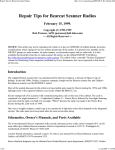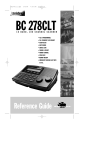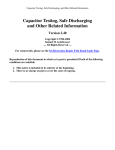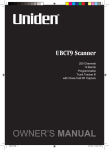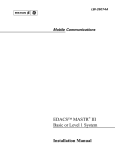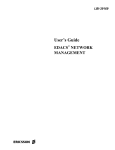Download EQUIPMENT AND ACCESSORIES FOR YOUR
Transcript
S CANNER EQUIPMENT EQUIPMENT AND ACCESSORIES FOR YOUR MONITORING POST Bob Parnass, AJ9S [email protected] www.megsinet.com/parnass Radio Shack PRO-92 Portable Multi System Trunking Scanner T he Radio Shack PRO-92 is a portable scanner capable of monitoring conventional, Motorola trunked (type I, II, and hybrid), Ericsson EDACS trunked, and E. F. Johnson LTR trunked systems. Built in Japan, it is among the first trunking scanners manufactured by GRE for Radio Shack. The PRO-92 is not a general coverage radio; it tunes the upper portion of the 10 meter ham band and the standard “scanner bands,” as well as the 806 - 960 MHz range. It also functions as a “weather alert radio,” displaying the level and type of alert from NOAA weather station broadcasts within your reception area. You cannot program specific codes for your location as you can in a Uniden BC278CLT. n Power to the People The PRO-92 runs on 9 VDC and its battery scheme is flexible. It is supplied with separate trays for 6 rechargeable and nonrechargeable AA cells. The latter disconnects the batteries when using an external power source. You can power the scanner from 117 VAC using an optional 9 VDC, 300 mA power supply (Radio Shack #273-1825) fitted with the proper plug. Connecting a power source to the side mounted PWR jack charges the internal batteries when using the proper holder. A current limiter inside the PRO-92 sets the recharge time for standard NiCd cells to about 16 hours. You can operate the PRO-92 while recharging, though it will take longer for a full charge. You can program the PRO-92 with a computer (interface kit not supplied) or clone one PRO-92 from another using the cable provided. n Memory The PRO-92 provides 500 memory channels in 10 banks, numbered 0 - 9. Both channels and banks are numbered differently from other Radio Shack models. The first bank (0), for example, contains channels 000 - 049, the second bank (1) has channels 100 - 149. As you can see, the bank number is used as the first digit of the channel number. Each memory channel is programmed with a frequency and what Radio Shack calls a “mode.” The modes are AM, FM, Motorola Trunked, EDACS, LTR, PL, and DL (digital PL). You can mix combinations of conven- MEASUREMENTS RADIO SHACK PRO-92 SCANNER S/N 011022 List price $349.99 Tandy Corp. Fort Worth, TX 76102 Frequency coverage (MHz): 29 - 54 (5, 10, 15, 20, 25, 30, 50 100 kHz steps) 108 - 137 (AM, 12.5, 25, 50, 100 kHz steps) 137 - 174 (5, 10, 15, 20, 25, 30, 50 100 kHz steps) 380 - 512 (12.5, 25, 50, 100 kHz steps) 806 -960 (cellular omitted, 12.5, 25, 50, 100 kHz steps) Sensitivity: see graphs RF attenuator: 20 dB @ 30 MHz 20 dB @ 150 MHz 15 dB @ 450 MHz 21 dB@ 950 MHz FM modulation acceptance: 12 kHz 96 MONITORING TIMES January 2000 Intermediate Frequencies: 257.5, 21.4, 0.455 MHz Image rejection: 50 dB @ 30 MHz 73 dB at 155 MHz 64 dB at 400MHz Audio output power at earphone jack: 146 mW @ 10% distortion into 8 ohms Practical memory scan speed: 29 ch/sec., conventional mode Current consumption at 9 VDC: off - 0 mA manual - 89 mA scan - 89 mA full volume - 170 mA Battery saver: after 5 seconds in Manual. Low battery shutdown at 5.89 VDC or less. tional and trunked frequencies within the same bank, but frequencies for each EDACS trunked system must be programmed into their own separate bank. PL and DPL are abbreviations derived from Motorola’s trademarked terms Private Line (continuous tone coded squelch or CTCSS) and Digital Private Line (digital coded squelch). The PRO-92’s PL and DPL capabilities are remarkable because the associated code is detected on a signal and displayed almost instantaneously! Each channel may be programmed with a 12 character label which is displayed along with the frequency. Each memory bank may have its own text label, but bank labels are not displayed while trunking or on channels assigned a PL or DPL code. A built-in attenuator may be enabled on or off on a per-channel basis, though we didn’t need to use it. n Scanning and Searching As you might expect, memory banks can be sequentially scanned in any combination. We programmed three banks with conventional AM and FM frequencies, three banks with different Motorola trunked systems, one bank with an EDACS trunked system, and one bank with a local LTR trunked business system. Our PRO-92 scans all those banks in turn. There is no apparent delay when our PRO-92 transitions between conventional, Motorola trunked, or LTR trunked banks; however, there’s a delay of approximately 3 seconds while our PRO-92 is in the EDACS bank. For trunking, one can program up to 100 talk group IDs in each of the 10 banks. You can lock out talk groups from these lists, and conversations in these groups won’t be scanned, but you cannot lock them out while searching (i.e., scanning in the Open mode). While scanning trunked systems, you can instruct the PRO-92 to “camp out,” or hold, on a particular talk group. It will scan all the trunked frequencies in the current bank, stopping only on conversations in that talk group. The PRO-92 supports a search with 10 pairs of frequency limits, and you can search multiple ranges sequentially. Up to 50 frequencies may be locked out in each bank. There is no auto store feature. n Multi Line Display The PRO-92 is built with a 4-line, dot matrix, liquid crystal display. One may adjust the contrast through a keypad sequence. Pressing another key lights the display, but the lamps cannot be latched on. The green backlighting is too dim to illuminate the entire display. It is useful in total darkness, but our display is often difficult to see during the day unless in a well lighted area. The display shows frequencies, channel, and other indicators. Even with 4 lines, the PRO-92’s display can only show so much. While the PRO-92 is stopped on a signal, the first line shows the channel number and other status information. For trunked channels, the remaining 3 lines show frequency, channel label, and talk group label. n Subtleties The PRO-92 is a complex radio and some aspects of the way it works may not be obvious after a quick reading of the owner’s manual. You must program EDACS frequencies in the proper order, in a separate bank, starting with the second memory channel (01) in that bank. If you start programming them at the first channel (00), the PRO-92 won’t track them properly. Some PRO-92 features – for example, the 2 second rescan delay – are implemented for conventional systems and don’t function while the PRO-92 is monitoring trunked activity. Bank text labels are not displayed for trunked frequencies. The 4th line on the display shows talk group information instead. The manual states that priority won’t work while trunking, but priority appeared to work while we scanned Motorola and LTR trunked systems. That’s a bonus! The PL and DPL squelch is only effective while scanning in the Closed mode. We could find no way to configure the PRO-92 to sit on a single channel with PL or DPL, and prevent signals without the proper code from opening the squelch. An impractical work-around is to lock out or clear all the other channels in the bank, then press the Scan key. You can lock out talk groups from being scanned but not from being searched; this makes searching for new talk groups more time consuming. The Uniden TrunkTrackers support multiple talk group lists per bank vs. one list per bank in the PRO-92. To obtain the same functionality in the PRO-92, you could program the same trunked system frequencies into several channel banks, and program the corresponding talk group lists differently, e.g., one for police, another for fire, etc. n the monster, megachannel, trunked systems in California and other urban areas. Our PRO-92 tracked local systems well, though as mentioned in the user manual, the wrong talk group labels flashed occasionally on weak signals. It follows conversations when held on a chosen talk group, but it missed a few call-backs in the EDACS system. The scan speed is acceptable. Will the good performance “scale up” when monitoring huge trunked systems? Will the PRO-92 miss more call-backs? We cannot answer this question with only small to medium sized trunked systems nearby. n Overall It’s gratifying to see another manufacturer (GRE) offer a trunking scanner. The PRO-92 is anything but a simple first offering. It is a top quality, feature rich model with almost everything one could want, except full frequency coverage and auto store during search. The PL and DPL squelch should be designed to function while in manual mode. That aside, the PRO-92’s instantaneous PL/DPL code display is awesome. We like being able to use AA batteries in the PRO-92, too. Performance Our PRO-92 produces clean, crisp audio. It is sensitive and has excellent image rejection. We did hear cellular phone transmissions in the 51 MHz range when driving within 1/4 mile of cellular phone transmitters. The PRO-92 and Uniden TrunkTrackers employ different schemes for following trunked conversations, and the merits of one method over the other is hotly discussed over the Internet. The trunked systems we monitored are comprised of 5 - 7 channels, smaller than RadioMap Transmitter sites in your area are researched and marked on a beautiful 8-1/2 x 11 full color plot. See FCC licensed sites from VLF through microwave including police, fire, cellular phone sites, business, industrial, broadcasters and selected FAA transmitter sites. Callsigns, frequency assignments, and names provided. Ham radio stations not included. You choose the map center location–your neighborhood, near your office, around sports stadiums–anywhere within the United States. We adjust map coverage for best readability, depending on transmitter site density. Invaluable to radio professionals and hobbyists for identifying towers, sources of radio interference etc. Send nearest street intersection and check for $29.95 payable to Robert Parnass. January 2000 Robert Parnass, M.S. Radio Electronics Consulting 2350 Douglas Road, Oswego, IL 60543 MONITORING TIMES 97


